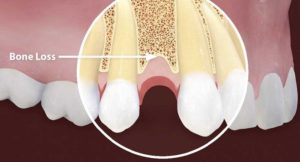Periodontal disease, also known as gum disease, is a series of inflammations that affect the tissues around the teeth. In an early stage called gingivitis, the gums are swollen, red, and may bleed. Periodontitis, a more serious form of periodontitis, can pull it away from the tooth, bone can be lost, and the tooth can become loose or fall out. Bad breath can also occur. Dangers of Gum Disease
 Image Credit: (mission implant center)
Image Credit: (mission implant center)
The radiograph shows bone loss (black area) between the two roots of the tooth. Due to infection under the tooth, the spongy bone has receded, reducing bony support for the tooth.
Periodontal disease is usually caused by bacteria in the mouth that infect the tissues around the teeth. Risk factors include smoking, diabetes, HIV/AIDS, family history, and certain medications. Diagnosis is made by examining the gum tissue both visually surrounding the tooth and using probes and X-rays to look for bone loss around the tooth.
Treatment involves good oral hygiene and regular professional dental cleanings. Recommended oral hygiene includes daily brushing and flossing. In some cases, antibiotics or dental surgery are recommended. An estimated 538 million people worldwide will be affected in 2015. In the United States, nearly half of people over the age of 30 are affected to some degree, while about 70 percent of people over the age of 65 are affected. Men are affected more than women.
Signs and symptoms

Image Credit: (yourgumspecialist)
In the early stages, periodontitis has few symptoms, and in many people, the disease must have progressed significantly before seeking treatment. Dangers of Gum Disease
Symptoms may include:
Redness or bleeding gums while brushing, flossing, or biting into hard foods (eg, apples) (although this may occur even in gingivitis, in the absence of attachment loss)
- Swollen gums recur
- vomiting blood after brushing teeth
- Bad breath, or bad breath, and a persistent metallic taste in the mouth
- The gums recede, causing the teeth to grow noticeably longer. (It can also be caused by brushing too hard or with a hard toothbrush.)
- Deep pockets between teeth and gums (pouches are sites where attachments have been gradually destroyed by collagen-destroying enzymes, called collagenases)
- Loose teeth, in later stages (although it can also occur for other reasons)
People should be aware that gum inflammation and bone destruction are largely painless. As a result, one might mistake the insignificant painless bleeding after cleaning the teeth, even though this may be a symptom of periodontitis in that person.
5 major causes of gum disease
- The main cause of gingivitis is poor or ineffective oral hygiene, which results in the buildup of a fungal and bacterial matrix called plaque at the gum line. Other causes are malnutrition and underlying medical problems, such as diabetes. People with diabetes must approach home care with care to manage periodontal disease. The new finger prick test has been approved by the U.S. Food and Drug Administration (FDA) in the U.S. and is being used in dental offices to identify and screen people for possible gum disease, such as diabetes.
- Smoking is another factor that directly or indirectly increases the incidence of periodontitis and may interfere with or hinder its treatment. It is arguably the most important environmental risk factor for periodontitis. Studies show that smokers lose more bone, adhesion, and teeth than non-smokers. The reason is that smoking has multiple effects on the immune response, including:
- poor wound healing
- inhibit antibody production
- It reduces neutrophil phagocytosis
- Some researchers believe that periodontitis may be associated with higher stress. Periodontitis was more common in people with lower socioeconomic size than in those with higher socioeconomic size.
- Genetics appears to play a role in determining the risk of periodontitis. Genetics is thought to explain why some people with well-controlled plaque develop advanced periodontitis, while others with poor oral hygiene do not. Genetic factors that can alter a person’s risk of developing periodontitis include:
- Phagocytosis deficiency: Humans may have unresponsive phagocytes.
- Overproduction of interleukins, prostaglandins and cytokines. This leads to a massive immune response.
- Interleukin 1 (IL-1) gene polymorphism: People with this polymorphism produce more IL-1 and are subsequently more likely to develop chronic periodontitis.
- Diabetes appears to exacerbate the onset, progression, and severity of periodontitis. Although most studies have focused on type 2 diabetes, type 1 diabetes appears to have the same effect on the risk of periodontitis. The extent of the increased risk of periodontitis depends on the level of glycemic control. Thus, in well-managed diabetes, diabetes appears to have little effect on the risk of periodontitis. However, the risk increased exponentially as glycemic control deteriorated. Overall, people with diabetes had a two- to three-fold increased risk of developing periodontitis. So far, the underlying mechanism of this link is not fully understood, but it is known to involve aspects such as inflammation, immune function, neutrophil activity, and cytokine biology.
How to prevention periodontal disease
- Daily oral hygiene measures to prevent oral disease include:
- Regularly (at least twice a day) brushing properly and trying to place the bristles of your toothbrush below the gum line can help destroy bacterial-fungal growth and the formation of subgingival plaque.
- Floss daily and use an interdental brush (if there is enough space between the teeth), as well as every quarter to clean the last tooth, after the third molar
- Use an antibacterial mouthwash: Although chlorhexidine gluconate-based mouthwashes cannot reverse any loss of attachments due to periodontitis, they can cure gingivitis.
- Regular dental exams and professional tooth cleanings as needed: Dental exams are used to monitor a patient’s oral hygiene practices and levels of attachment around the teeth, identify any early signs of periodontitis, and monitor response to treatment.
